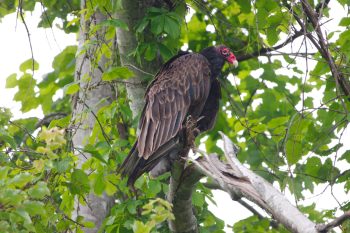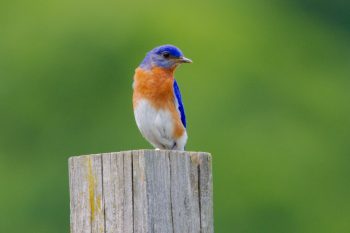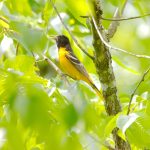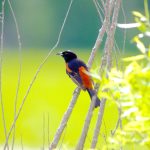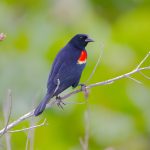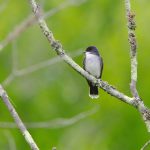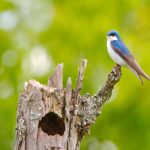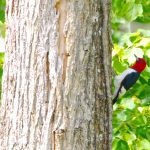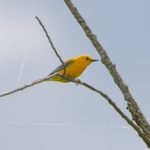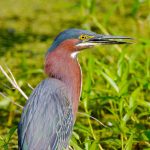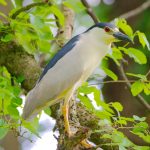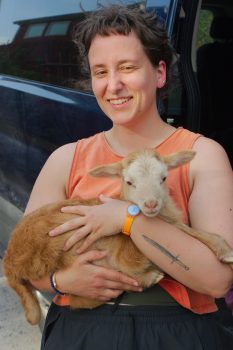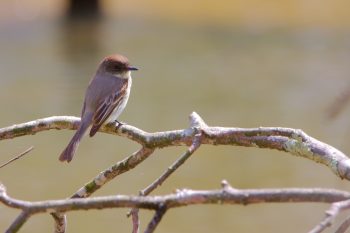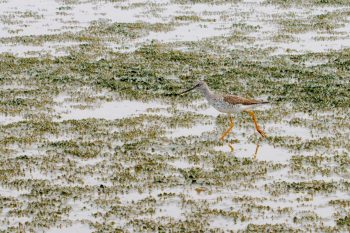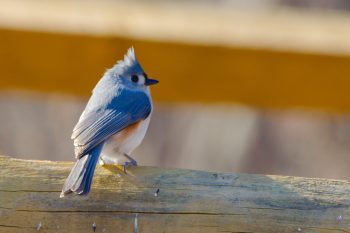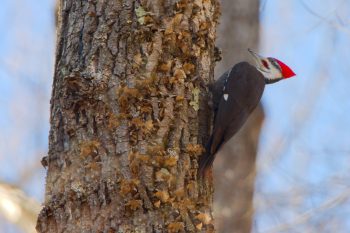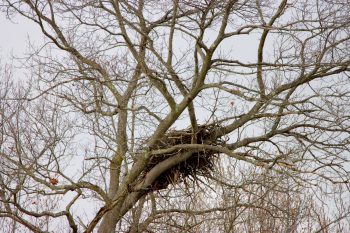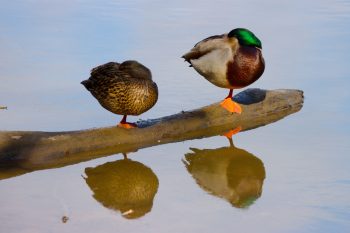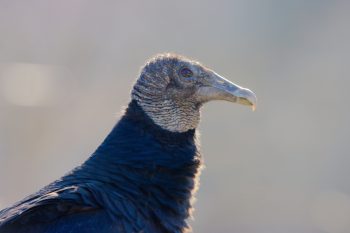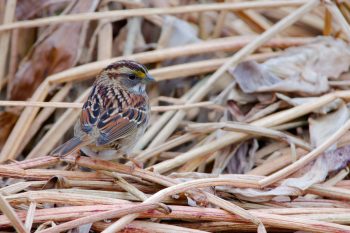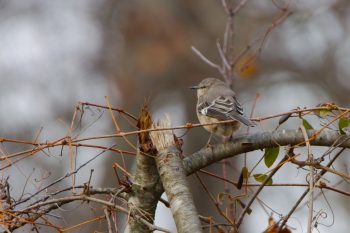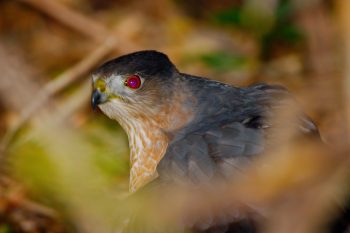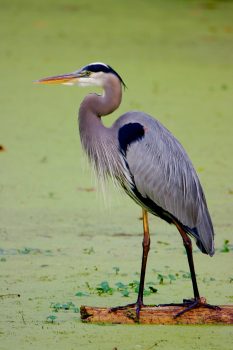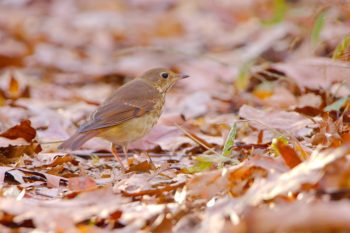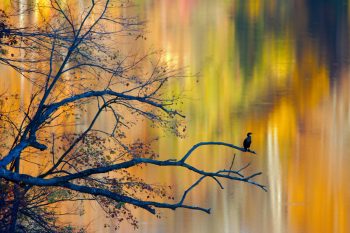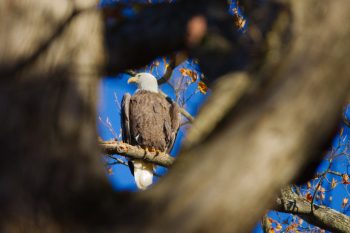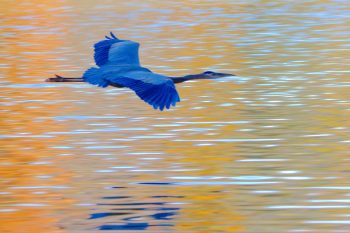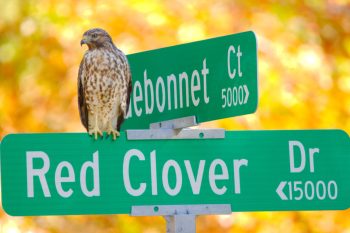We went to Pennyfield Lock on the C&O Canal today, walking upstream just a little less than 2 miles. We took it fairly slowly and stopped to listen for—and even occasionally photograph—birds. The Merlin app identified four vireos (red-eyed, white-eyed, warbling, and yellow-throated), as well as indigo buntings, orchard oriole, and a few different fly- and gnat-catchers. I got a few nice photos of a great egret (Ardea alba), a couple great blue herons (Ardea herodias) and this turkey vulture (Cathartes aura). I also got photos that aren’t all that good but at least allowed me to identify a ruby-throated hummingbird (Archilochus colubris), an immature male orchard oriole (Icterus spurius), an indigo bunting (Passerina cyanea), and some black vultures (Coragyps atratus). The three smaller birds were way up in tree tops so the photos were not very good at all. Google lens tried to convince me that the orchard oriole was an Asian golden weaver (Ploceus hypoxanthus). Even when I included ‘Maryland’ in my description, it insisted that the picture was not from Maryland because that bird doesn’t exist here. The Merlin app did a better job with it.
Creatures
Turkey Vulture (Cathartes aura)
Eastern Bluebird (Sialia sialis)
We went to the Agricultural History Farm Park today and, among other things, we saw a lot of eastern bluebirds (Sialia sialis). We also saw a couple song sparrows (Melospiza melodia), European starlings (Sturnus vulgaris), a mockingbird (Mimus polyglottos), and an eastern kingbird (Tyrannus tyrannus). Not bad for a short visit. The photos of the bluebirds turned out quite well, I think showing off their colors really nicely. This is probably out best place to go to see those, although we’ve seen them even in our neighborhood.
Birds at McKee-Beshers
After the last two weeks, Cathy and I really needed a break. The trip to the National Arboretum was wonderful but even that was a place with lots of people. Today we went to McKee-Beshers Wildlife Management Area, out River Road.
We didn’t really know what to expect but it turned out to be one of our most fruitful bird outings ever, with thses nine birds photographed and a half dozen more seen and heard. We are big fans of the Merlin app by the Cornell Lab of Ornithology. Having that listen for and identify birds by their song helped us find birds we might not have otherwise seen. I recognized the oreole songs and of course the red-winged blackbird, but I never would have found the red-headed woodpecker or the prothonotary warbler. The night heron was actually at the C&O Canal near Riley’s Lock.
Dorothy and Kid Goat
Cathy, Dorothy, Jeff and I went out to Rocklands today. Among other things we had a nice, fairy long visit with Janis over a bottle of wine and a pizza. We also walked up to the road where Dorothy had done so much brush clearing a few years back. We also ran into Anna and her kids and we talked with them. Anna’s kids also had a kid, which Dorothy is holding in this photo.
We were there longer than we had expected but it was a beautiful day and nice to be out.
Eastern Phoebe (Sayornis phoebe)
Cathy and I went to Seneca Creek where Berryville Road passes right next to it. We saw a belted kingfisher (Megaceryle alcyon) on a tree leaning out over the water and I was able to get a few photos, although it was pretty far away. We walked upstream and enjoyed the bluebells (Mertensia virginica) that wrre pretty much in full bloom. Some of the flowers were brown, probably as a result of the recent freeze we had a week or so ago.
We heard quite a few birds, including wood thrush (Hylocichla mustelina) and northern waterthrush (Parkesia noveboracensis). We didn’t see either of those. A blue-gray gnatcatcher (Polioptila caerulea) kept showing up on Cathy’s Merlin screen but I didn’t expect to be able to see this little, elusive bird. We did, though, and I was able to get a photo or two.
Today’s photo is of an eastern phoebe (Sayornis phoebe) who sat on a branch over the creek and let me get fairly close.
Greater Yellowlegs (Tringa melanoleuca)
Cathy and I visited friends in Delaware this weekend. We went to Prime Hook, a National Wildlife Refuge on Delaware Bay. The background of this photo makes it a little hard to see the bird at first, but otherwise, I like the picture. This is a greater yellowlegs (Tringa melanoleuca). They are differentiated from the lesser yellowlegs (T. flavipes) by their size (if seen side by side), by the Greater’s longer, thicker and slightly upturned bill. While we are in the northern most extent of their winter range, they migrate through on their way to the mid-latitudes of Canada for the summer.
Tufted Titmouse (Baeolophus bicolor)
As mentioned in the previous post, we went to Croyden Creek this afternoon. After our walk, on which we saw the woodpecker, we returned to the nature center, where we had parked. I took a few pictures of birds around the feeders there. That included a northern mockingbird (Mimus polyglottos), a few dark-eyed juncos (Junco hyemalis), and this tufted titmouse (Baeolophus bicolor). This photo makes him look more blue than gray, but either way, it’s a cute little bird that is hear year round and is often heard repeating Peter-Peter.
Pileated Woodpecker (Dryocopus pileatus)
We went to Croyden Creek this afternoon, and walked the loop to the east, following the creek down towards Rock Creek, then looping up to near Norbeck Road and back to the old Avery Road cut. About a third of the way around we heard and then saw this pileated woodpecker (Dryocopus pileatus) high on a dead tree. They certainly are a treat to see, with their red crest, as they dig insects out of trees and stumps. Their call and the very deliberate thumping of their beak against the wood is unmistakable.
Bald Eagle Nest
We walked to Lake Frank today and I took a few pictures of the eagle nest across the lake but we didn’t see either of the eagles. There is a tree near the southern end of the lake where we often see one of them perched so we walked towards that. It had been raining earlier in the day but when we left on our walk the sun was out. As we walked south, the wind picked up and the sky turned grey. About the time we got to where the eagle often sits (but we didn’t see it today) the rain started. We turned for home and were pretty wet by the time we got back. A half hour later the sun was out again. Ah, spring.
Mallards (Anas platyrhynchos)
Second Christmas, like all good things, must come to an end. After another visit to grandma, we drove Jim, Abba, and Hannah to the airport a little before midday today. Their flight got cancelled but fortunately they were able to get on another flight and got home without any real problem. Cathy, Dorothy, and I walked the perimeter of of Theodore Roosevelt Island after dropping the others off. There wasn’t a lot going on but I did like these two mallards (Anas platyrhynchos) sitting on a log near the mouth of the marsh at the south end of the island.
Coragyps atratus (Black Vulture)
A few minutes after the previous photo was taken, this black vulture (Coragyps atratus) landed on a rock next to the Olmsted Island overlook. He (or she, I have no idea) posed nicely for me, sitting in profile while I was able to get fairly close, especially with my long lens. It lacks the developed sense of smell of our other native vulture, the slightly larger turkey vulture (Cathartes aura). It finds food, therefore, either by sight or by following turkey vultures. From a distance and while flying, the two vultures can be distinguished by the different patterns of grey and black on underside of the wings, the turkey vulture having much more grey. They both fly with dihedral (v-shaped) wings, which makes them easily distinguished from the more flat-winged hawks and eagles.
White-throated Sparrow (Zonotrichia albicollis)
We decided to go to Great Falls today. It’s probably the most interesting part of the C&O Canal that’s close enough to get to easily and since we don’t have to pay to get in (because we have an America The Beautiful, lifetime senior pass) the fee isn’t an impediment. After walking out to Olmsted Island, as per usual, we went downstream to Widewater. We saw a great blue heron and I got a few nice pictures of that, but since I posted on just a little while ago (and that’s a better picture than I got today anyway), I’m going with this nice shot of a white-throated sparrow (Zonotrichia albicollis). This is a familiar bird, best known for its distinctive “Poor Sam Peabody, Peabody, Peabody” song.
Northern Mockingbird (Mimus polyglottos)
We went for a short walk on the trails below Croyden Creek Nature Center today. There wasn’t a lot to be seen but it was still really good to be outdoors. Life has been a bit stressful lately and walking in the woods, particularly where there is water nearby, is good for us. This was the only bird we saw on the walk that I was anywhere near close enough to get a photograph. I did take a few of birds (goldfinches) on the feeders at the nature center, as well, but those didn’t turn out as well. This is our common, northern mockingbird (Mimus polyglottos).
Cooper’s or Sharp-shinned Hawk
An expert might be able to tell from this photo if this is a Cooper’s (Accipiter cooperii) or sharp-shinned (Accipiter striatus) hawk but I’m pretty sure it’s one or the other. Cathy saw this one and another both flying around our yard. This one landed under bushes on the edge of our yard and I was able to get a few worse photos and this one, that at least shows this much. I turned the on-camera flash on, because it was relatively dark out or this one would have certainly been as blurred as the others.
Great Blue Heron (Ardea herodias)
As mentioned in the previous post, we walked upstream along the Potomac River from Great Falls today. After about a mile on a trail down by the river, we returned to the towpath because a stream blocked our way. We could have returned to the river’s edge above the stream but we were ready to head back, anyway. A short way back towards Great Falls we saw this great blue heron (Ardea herodias) on the canal, posing very nicely for us. I like him (or her, I have no idea which) against the green of the duckweed on the surface of the canal.
Overall, I’m quite pleased with the 150-600mm Sigma lens I got a couple years ago. It’s a lot to carry but it certainly allows me to get pictures that I wouldn’t get otherwise. This one was taken zoomed all the way out to 600mm, which when you multiply it by 1.6, gives an effective focal length of 960mm compared to a full-frame 35mm camera. This one was taken with the lens on a monopod, which is how I generally carry it. The exposure was 1⁄100 second at f/6.3.
Hermit Thrush (Catharus guttatus)
As mentioned in the previous post, we went to the Rachel Carson Conservation Area this afternoon. We walked a fairly long loop, in a counterclockwise direction. The section down by the Hawlings River is our favorite part, along with the boulders in the previous post. I carried my long lens but we didn’t see much to photograph with that. Towards the end of the walk, though, we came across this hermit thrush (Catharus guttatus) who would move a little bit further down the trail as we got close and I was able to get near enough to get a pretty decent photo.
Double-crested Cormorant (Nannopterum auritum)
One more bird photo from our walk around Lake Frank today. As we crossed the dam at the south end of the lake we saw this bird on a tree with fall colors reflected off the water behind it. I’m assuming it’s a double-crested cormorant (Nannopterum auritum). Regardless, I’m fond of this photo. Looking back I didn’t take many pictures in October and those I took were concentrated on just a few days. Our lives are just that way right now, I guess. I take what I can get.
Bald Eagle (Haliaeetus leucocephalus)
On the southeast part of Lake Frank is an old boat ramp from when the lake had road access to vehicles. Near that is a very tall oak tree. We’ve see one or the other of our local bald eagles (Haliaeetus leucocephalus) in that tree on more than one occasion. We saw it today, first from across the lake and then, when we got to that part of the trail from below. It was easier to spot, frankly, from across the lake. When you get close, you sort of have to know where to look. The best view turned out to be through the crook of this closer tree.
Great Blue Heron (Ardea herodias)
As mentioned in my previous post of the red-shouldered hawk on the street sign, we went to Lake Frank this afternoon. We hadn’t planned to walk as far as we did but ended up walking all the way around the lake. We saw two great blue herons (Ardea herodias). The first one was across the lake so I wasn’t able to get any good photos of that. Shortly after stopping to look at it, though, this one flew across in front of us. I didn’t have much time to focus, zoom, or frame the shot and was glad to get what I did. The very blue color of the bird has more to do with it being in the shadows than it’s natural coloring (per its name).
Red-shouldered Hawk (Buteo lineatus)
Four days ago I posted a photo of what I identified as a red-shouldered hawk (Buteo lineatus) or possibly a broad-winged hawk (Buteo platypterus) taken in our back yard. Today I got a photo of what may be the same bird on a street sign. This is a much better view of the bird and I love the colors with the green of the sign and the yellow leaves in the background. Anyway, I still think it’s a red-shoulderd hawk but still am not sure, being no expert. We were getting ready to go for a walk when we saw this, so I’ve got three more bird pictures to come, both from that walk. Stay tuned.

